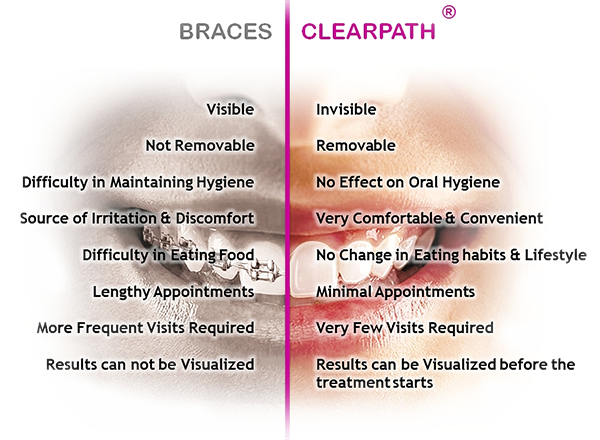ClearPath aligners are transparent / invisible. These are a cosmetic & hygienic alternative to the conventional metal braces. Many adults spend their entire lives covering their mouths when they laugh, smile or talk. They feel stuck because they do not want to wear braces due to pain, irritation, discomfort and social inhibitions. Now there is an effective, safe and clinically proven cosmetic solution that fits your lifestyle. So if you are planning to correct your malocclusion without any discomfort or social inhibitions due to unsightly braces / wires, ClearPath is the right choice for you. ClearPath Invisible Aligners also offer predictable results visualization even before the treatment begins.
Clear Braces

FOR THE DOCTOR
ACCURACY of regeneration of patient occlusion without any digital data manipulation, eliminating any potential inaccuracy of appliance fit.
MORE CONTROL OVER TREATMENT with our batch aligner shipment products where treatment can be modified in between batches during the course of treatment.
SUPERIOR CLARITY OF ALIGNERS compared to other aligners available in the market which makes it more transparent and a hygienic choice.
FASTER TURNAROUND TIME from the time a case is received to the time aligners are shipped back to the doctor.
UNLIMITED MODIFICATIONS to the diagnostic setup are allowed
ACCURACY OF THE VERTICAL RELATION established at the beginning and at the end of treatment through a unique articulation process.
ACCURACY OF THE VERTICAL RELATION established at the beginning and at the end of treatment through a unique articulation process.
Original Patient Data used during the whole manufacturing process from casting to treatments and aligner fabrication which adds to the accuracy of the end product and ensures BETTER TREATMENT OUTCOME.
PRECISION OF MOVEMENT: The entire process is designed to deliver customized aligner that moves each tooth directly along the most efficient way to achieve the desired goal. By optimizing each aligners output, you minimize the number of aligners and intermediate changes required leading to shorter treatment times for patients, and increased capacity for practice.
Original gum tissue is used to fabricate aligners, thus providing LESSER NUMBER OF CLINICAL MODIFICATIONS at the time of insertion of aligners.
LIMITATIONS OF BRACES
Although braces are generally effective in correcting a wide range of malocclusions, they are subject to many limitations and disadvantages. Conventional orthodontic treatment is associated with:
UNATTRACTIVE APPEARANCE: Braces call attention to the patient condition and treatment. In addition, braces trap food, which can further compromise appearance. Braces can also result in permanent discoloration of teeth. Many adults associate braces with adolescence.
ORAL DISCOMFORT: Braces are sharp and bulky and can abrade and irritate the interior surfaces of the mouth. The tightening or adjustment of braces results in root and gum soreness and discomfort, especially in the few days immediately following an orthodontic visit.
POOR ORAL HYGIENE: Braces compromise oral hygiene by making it more difficult to brush and floss. These problems can result in tooth decay and periodontal damage. Additionally, the bonding of brackets to teeth can cause permanent markings on the teeth.
INABILITY TO PROJECT TREATMENT: Historically, dental professionals have not had means to model the movement of teeth over a course of treatment. Accordingly, they must rely on intuition and judgment to plan and project treatment. As a result, they cannot be precise about the direction or distance of expected tooth movement between patient visits. This lack of predictability may result in unwanted tooth movements and can limit the their ability to estimate the duration of treatment.
PHYSICAL DEMANDS ON DENTAL PROFESSIONAL: The manipulation of wires and brackets requires sustained manual dexterity and visual acuity, and may place other physical burdens on the dental professionals.
ROOT RESORPTION: The sustained high levels of force associated with conventional treatment can result in root resorption, which is a shortening of tooth roots. This shortening can have substantial adverse periodontal consequences for the patient.
EMERGENCIES: At times, braces need to be repaired or replaced on an emergency basis. Such emergencies cause significant inconvenience to both the patient and the dental professional.
